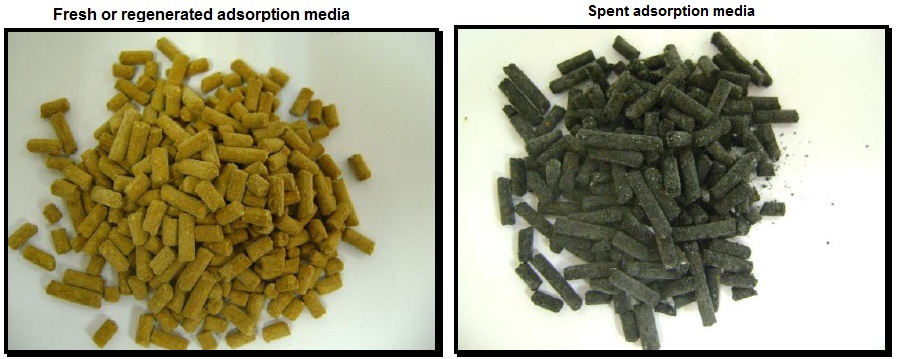H2S and Sulphur adsorption media
BIO Fe Adsorption media is granular clay based media impregnated with a ferric hydroxide medium. The adsorption media removes H2S and Sulphur compounds from air and gas streams. Other components of energetic value such as Methane will pass through the media and can be easily used as fuel.
This product is particularly efficient in the Biogas energy recovery process.
It has a high H2S removal capacity in anaerobic conditions.
Working temperature range 25 to 90ºC
Read more
H2S is stripped from the gas stream according to the following chemical reactions. The ferric hydroxide coating on BIO Fe reacts with H2S:
- 2Fe(OH)3 + H2S » 2Fe(OH)2 + 2H2O + 1/8 S8
- 2Fe(OH)2 + 2H2S » 2FeS + 4H2O
This reaction results in the creation of ferrous sulphide, which turns the media black.
Regeneration Operation: BIO Fe can be easily regenerated. The Ferrous Sulphide can be converted back to Ferric Hydroxide by blowing air through the media filter.
2FeS + 3/202 + 3H2O » 2Fe(OH)3 + 1/4S8
Oxygen converts the FeS (Ferrous Sulphide) to ferric hydroxide and elemental sulphur that remains trapped in the media.
There is a visual colour indicator to show when the media is returning from Black (saturated media) to its original light Brown colour with small sulphur particles attached.
10 to 19 Regeneration Operations are possible, a minimum adsorption capacity of 400 mg H2S per gram of BIO Fe media. Each regeneration operation will absorb 40mg of H2S per gram of media. If Oxygen is present in small quantities in the Biogas, there is constant regeneration of the media through the Oxygen in the air flow.
Biogas Power Production Operational Cost
The Operational Costs to produce Electricity can be much higher if there is no Corrosion Control in Biogas recovery process. Biogas contains H2S that must be removed as much as possible before reaching the gas processing equipment. H2S causes severe problems with the gas processing equipment as the equipment is extremely sensitive to hydrogen sulphide. If H2S is removed, we can improve equipment efficiency by reducing maintenance, reventing downtime, and enhancing energy production. The hydrogen sulphide issue is a critical factor for technologies that use the biogas. If the H2S levels are too high, damage to gas treatment equipment is severe and costly.
Active Sulphur Compounds rapidly attack copper, silver, aluminium and iron alloys. The presence of moisture and small amounts of inorganic chlorine compounds greatly accelerates sulphide corrosion. Active Sulphurs ranks with inorganic chlorides as the predominant cause of atmospheric corrosion in the process industries. STANDARD ISA-S71.04-1985
BIO Fe Adsorption media is granular clay based media impregnated with a ferric hydroxide medium. The adsorption media removes H2S and Sulphur compounds from air and gas streams. Other components of energetic value such as Methane will pass through the media and can be easily used as fuel.
This product is particularly efficient in the Biogas energy recovery process.
It has a high H2S removal capacity in anaerobic conditions.
Working temperature range 25 to 90ºC
H2S is stripped from the gas stream according to the following chemical reactions. The ferric hydroxide coating on BIO Fe reacts with H2S:
- 2Fe(OH)3 + H2S » 2Fe(OH)2 + 2H2O + 1/8 S8
- 2Fe(OH)2 + 2H2S » 2FeS + 4H2O
This reaction results in the creation of ferrous sulphide, which turns the media black.
Regeneration Operation: BIO Fe can be easily regenerated. The Ferrous Sulphide can be converted back to Ferric Hydroxide by blowing air through the media filter.
2FeS + 3/202 + 3H2O » 2Fe(OH)3 + 1/4S8
Oxygen converts the FeS (Ferrous Sulphide) to ferric hydroxide and elemental sulphur that remains trapped in the media.
There is a visual colour indicator to show when the media is returning from Black (saturated media) to its original light Brown colour with small sulphur particles attached.
10 to 19 Regeneration Operations are possible, a minimum adsorption capacity of 400 mg H2S per gram of BIO Fe media. Each regeneration operation will absorb 40mg of H2S per gram of media. If Oxygen is present in small quantities in the Biogas, there is constant regeneration of the media through the Oxygen in the air flow.
Biogas Power Production Operational Cost
The Operational Costs to produce Electricity can be much higher if there is no Corrosion Control in Biogas recovery process. Biogas contains H2S that must be removed as much as possible before reaching the gas processing equipment. H2S causes severe problems with the gas processing equipment as the equipment is extremely sensitive to hydrogen sulphide. If H2S is removed, we can improve equipment efficiency by reducing maintenance, reventing downtime, and enhancing energy production. The hydrogen sulphide issue is a critical factor for technologies that use the biogas. If the H2S levels are too high, damage to gas treatment equipment is severe and costly.
Active Sulphur Compounds rapidly attack copper, silver, aluminium and iron alloys. The presence of moisture and small amounts of inorganic chlorine compounds greatly accelerates sulphide corrosion. Active Sulphurs ranks with inorganic chlorides as the predominant cause of atmospheric corrosion in the process industries. STANDARD ISA-S71.04-1985






